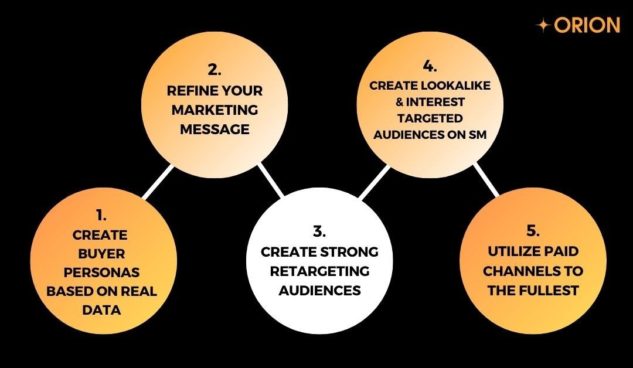This is a guest post written by Rayed Chaudhry, Co-founder of Orion, the official digital agency partner of SaaStock. Rayed is passionate about growing businesses and interested in implementing unique digital campaign tactics to help SaaS companies achieve growth.
Prioritizing product-market fit is crucial for all businesses, SaaS or not.
Businesses that do find their product-market fit increase their chances of success dramatically. But, in order to do so, one of the first steps all SaaS startups need to take is to understand their audience and refine their buyer personas.
There are many ways to go about this, and often it requires one to make intelligent assumptions based on evidence & experience.
But what if there was a way to complement your assumptions with real-life data?
Data that is accurate, coming from prospective users who are actually searching for solutions that your SaaS offers, and low hanging fruit in terms of likelihood of becoming your customer?
We’ve put together a step-by-step guide to a little known tactic that smart marketers are implementing to increase sales, improve buyer personas and create audiences in a cost-effective way using paid advertising channels.
The Current Way: How are SaaS companies building their buyer personas?
To begin with, many SaaS businesses use their gut feeling to come up with buyer personas. Though this may be cheap and quick to execute, you might be missing the mark completely. As the company matures a little, they also use primary & secondary research tactics such as:
- Focus groups – Getting feedback from a small group of people using group discussions & Q&A sessions
- Interviews – Talking to your customers about your product. This can be done at tradeshows, social media or even scheduling short 1-on-1 phone calls.
- Surveys – Using web-based services like SurveyMonkey to send & distribute questionnaires.
- Secondary Research – Learnings from other methods in which they were not directly involved, such as industry reports.
The ultimate goal of all of this research is to get to a point where you can answer questions such as:
- Which specific industry is your target group in?
- What role is the perfect buyer? And how about the perfect user?
- What are the ideal company and team sizes so it makes sense to use your solution?
Although the current way of researching the market works, it is costly in terms of time & resources and underlying assumptions that may or may not be correct.
The New Way: Defining Buyer Personas Using Real Data from Paid Advertising
So, how can early-stage SaaS startups use paid advertising channels to refine their audience, without breaking the bank?
Read on for our step-by-step guide.
Please note: For the purposes of this guide, we will use Benji – The Remote Workshop Company as an example and reference to when explaining the concepts and procedures. Benji is a new SaaS solution that enables trainers & educators to build a radically better remote workshop by providing tools that increase engagement and improve learning outcomes.
5 steps to define your buyer personas using social media: A step-by-step guide
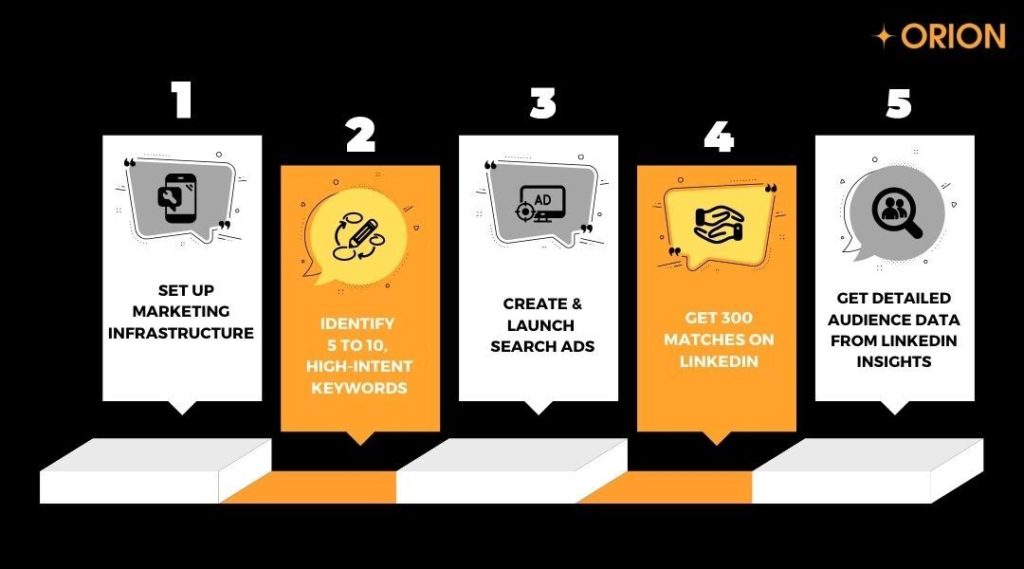
Step 1: Set up of marketing infrastructure
Before getting started, one of the first things you need to do is make sure you have all the right tools and infrastructure set up for success.
Here’s what you will need:
- Google Tag Manager javascript on your website so you can take the necessary tracking setup steps without the help of a developer
- A Google Ad Account & conversion tracking
- A Bing Ad Account (in the US many people use Bing as their preferred search engine)
- LinkedIn Ad Account & Pixel set up on your website
- Facebook Ad Account & Pixel set up on your website
Many SaaS companies have this infrastructure in place already. If you do not have these already set up, you can check out this guide to all the tracking, analytics & reporting needs for your SaaS.
For the purposes of this guide, we will go through the setup of the LinkedIn pixel and audience insights in the video below.
This is the single most important part of setting up the infrastructure so that you can get important insights & real data.
Step 2: Identify 5 to 10, high-intent keywords
In this step, you need to look at your SaaS solution and come up with at least five very specific keywords/search phrases. Typically this would be something your prospective user is searching for in order to solve a problem that your SaaS helps with.
Some factors to consider when choosing your keywords:
- The more specific your keywords, the better data you will be able to get
- Keep in mind that the more specific your keywords, the less available search volume there will be.
- Use different keyword match types to really extract the right keywords. So for example, if you are not sure what people are searching for exactly, use the “Broad Match Modifier keyword match type” to target a group of keywords that all need to be in the search term simultaneously, without a specific order
- Depending on the budget at hand, you can start with a larger number of keywords. Remember, the more keywords you have, the more budget you will need to test and acquire your data adequately.
In the case of Benji, after using Google’s Keyword Planner and our own product understanding, we came up with these keywords to target.
- Remote Learning Platform
- Interactive Online Workshops
- Interactive Training
- Online Teaching Tools
- Interactive Workshops
- Plus some more variations of the above keywords
Because we were not initially sure about what exact search phrases users were typing into their search bars, we started with the Broad Match Modifier keyword match type.
Step 3: Launch Search Ads for these Keywords on Google & Bing
We created some simple, direct response copy for these keywords and launched them. One of the ads that performed well is in the screenshot below:
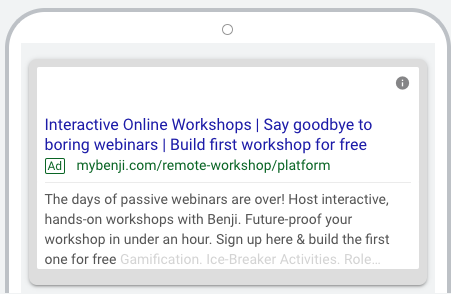
After running the ads for a month, at a small budget of $50 per day, these were the results per keyword.
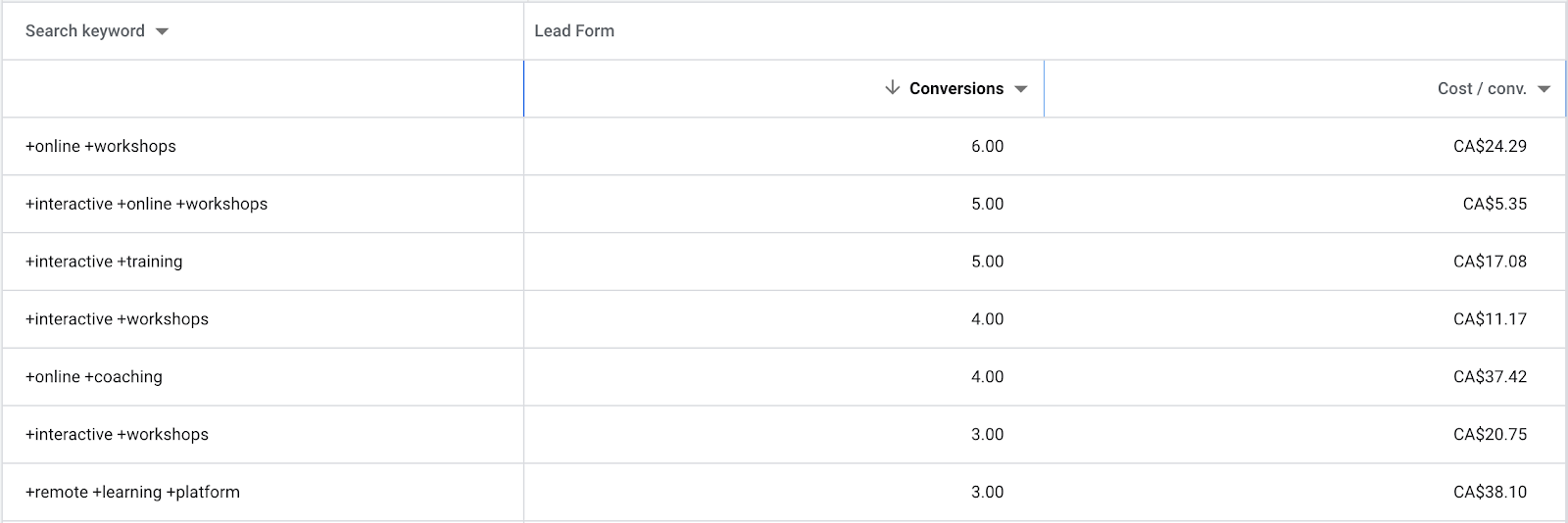
In running this test, we were also able to identify the exact search phrases users were searching on and were able to move our match types to Exact Match and bring the cost per lead down considerably.
The image below shows how the exact search terms performed in terms of conversions.
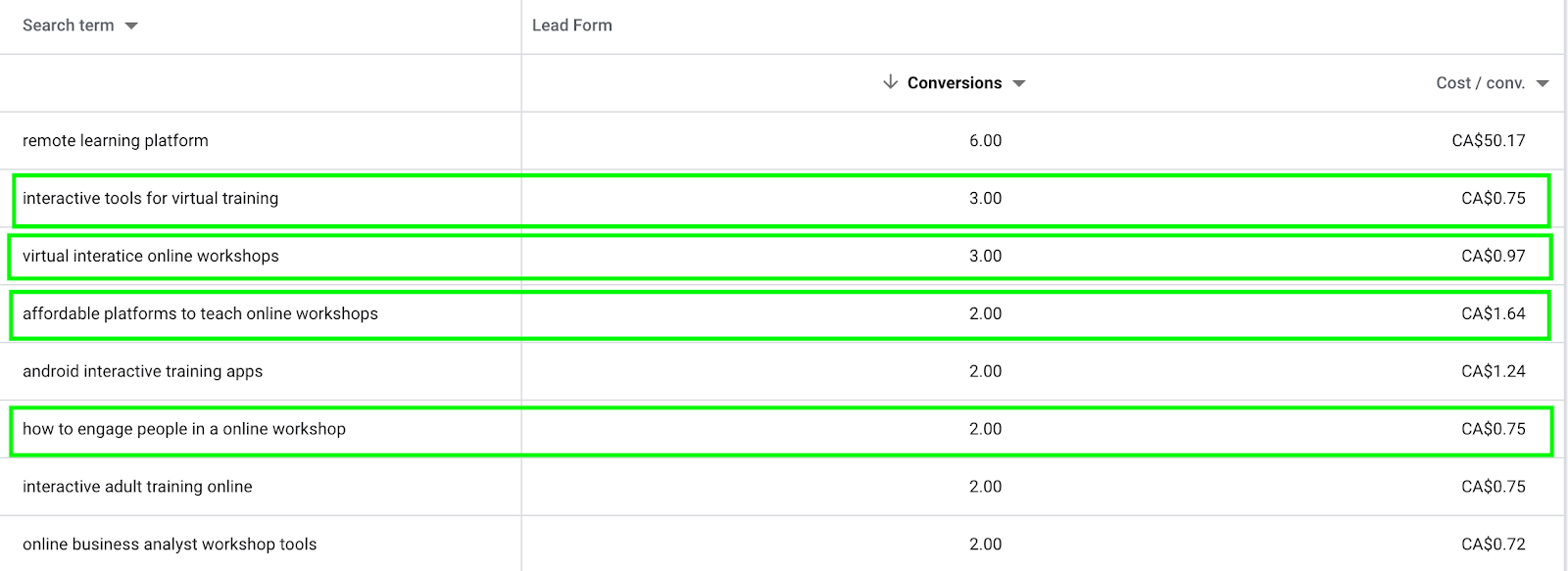
Summary thus far:
So far we’ve launched super-targeted and highly relevant ads to people who are searching for Benji’s solution. We’ve been able to acquire a number of leads that the sales team can now focus on converting and we’ve been able to do that while staying within a friendly, early-stage SaaS startup budget.
And it gets better from here.
Step 4: Wait for 300 matches (the wait will be worth it)
Now you’ve got traffic coming onto your website through highly-targeted Google and Bing search ads. Depending on the geographies you are targeting, and also how much organic traffic you have, the waiting period here can take a few hours all the way up to a few days/weeks.
As shown in the LinkedIn pixel setup video in step 1 of this guide, we will need to wait until LinkedIn is able to match 300 people who are logged into their LinkedIn, and also visit your website at the same time.
Please note: The more number of matches you have, the more accurate and actionable your data insights will be. 300 is just the minimum LinkedIn requires before it starts providing data insights without compromising on their user’s privacy.
While you wait for your 300 matches, this is the screen you will see when you visit the Website Demographics section of the LinkedIn Campaign Manager.
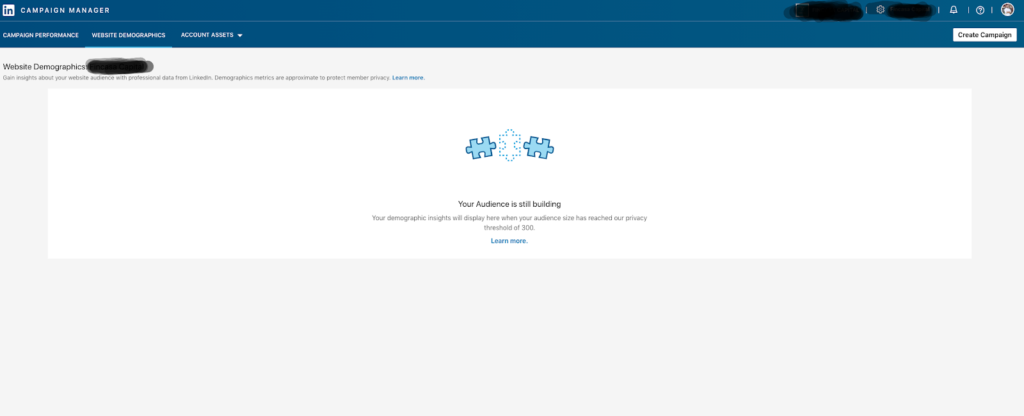
Keep checking back periodically to see if and when you have hit your threshold. Once you have hit your Threshold, it’s time for step 5.
Step 5: Go to the LinkedIn Insights to extract detailed, user-provided audience data points
You should now be ready to enrich your buyer personas with real, actionable data insights.
Data variables you can extract include:
- Job titles
- Company Industry
- Job seniority
- Company Size
- Job Function
The video below explains exactly how you can extract this data from LinkedIn.
So you’ve got the insights. But can they be trusted? And why?
The short answer is yes:
- The data being collected is provided directly by the users on the LinkedIn platform. Therefore, the data can be considered as accurate and up to date
- The ads being run are tight-knit and only focused on very high-intent keywords. This ensures that any traffic coming onto your website from these ads is very relevant and likely to be people who really do need your product
- Instead of using assumptions, you are now using actual data from highly-relevant audiences to build your personas
Next steps: How to make most of this data?
Getting these insights is only the first step. How you use them is where you can make the most out of this simple tactic. Here are five ideas to help you use this buyer persona data:
- Use data such as job position, seniority, company size & industry to get deeper into your buyer personas and really refine them for future use
- Create a consistent flow of high-intent leads coming into your sales funnel at a low cost. For early-stage SaaS startups, this can be great. It keeps your sales funnel filled with leads, and gives you constant access to conversations to better refine your marketing message
- Once you have enough traffic & leads, you can use it to create Lookalike audiences on Facebook & LinkedIn. These audiences will be particularly strong because you are only feeding your website with relevant & high-intent traffic
- Use this data to create personalized marketing messages, and target more relevant interests from the word go.
- Retarget users who came to your website through the high-intent search ads
Conclusion
Paid advertising can be an expensive method to acquire customers. However, by using tactics such as these, you can significantly reduce the costs of your paid advertising, and then leverage the data gathered to super-charge your marketing efforts.
This is especially true for early-stage SaaS startups who have budget restrictions in place before they really find their product-market fit and scaling opportunities.
